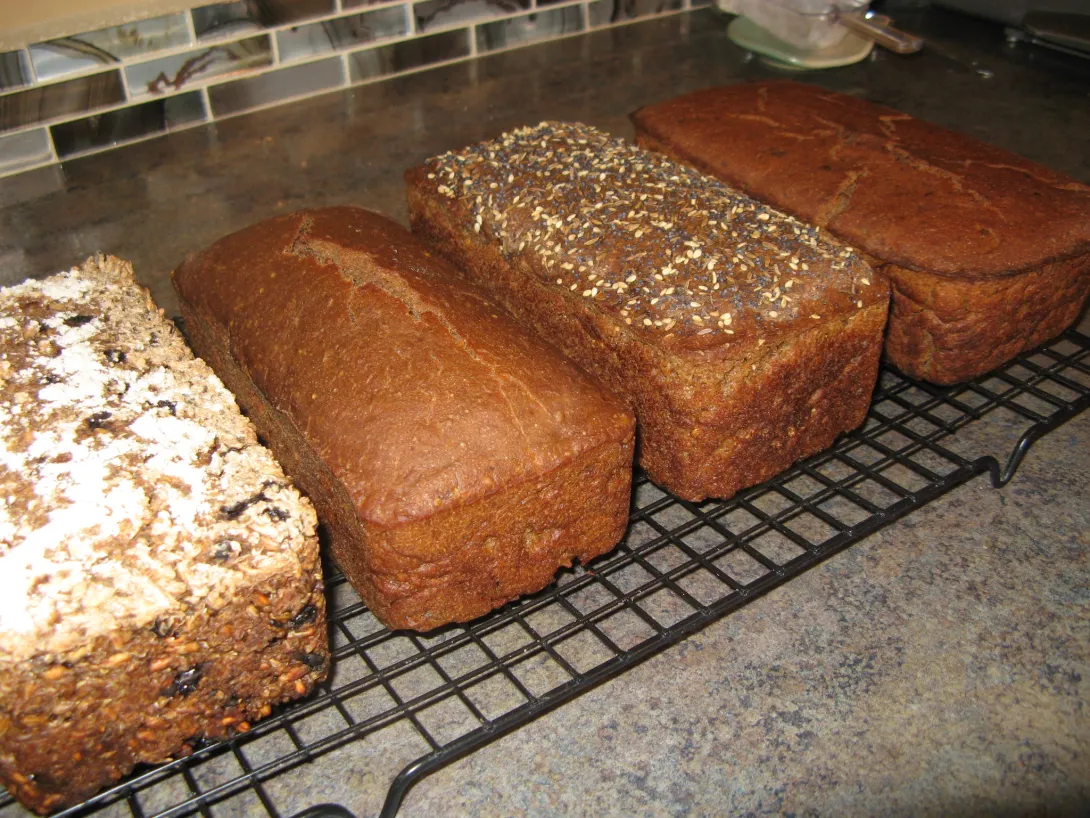Lazy Loafer's blog
Another all-rye bake

I've been baking rye sourdoughs over the last few days, for a special customer request. They turned out fairly nice, but I still have challenges with my rye starter staying strong enough to rise the bread properly. As a result some of them were a bit dense and wet (unlike the previous rye bake, where they rose nicely; not sure where the difference lies). Still fairly happy with them. From left to right they are:
Playing with flavour - add-ins

At the bread tasting a couple of weeks ago, I made a series of six sourdoughs that all had the same formula and technique, with the exception of 25% of the flour being different. One of the popular ones was made with 25% Kamut flour. I was a little surprised that the Kamut seemed quite thirsty and also very strong. The dough seemed drier and much tighter than the doughs made with other flours. But the resulting bread was nice.
Cinnamon bread

I have a customer who has teenage children. She buys a lot of different kinds of bread from me, but she was still buying cinnamon bread from a local chain because her kids love it. She asked it I ever made something like that. I found the ingredients online:
Ingredients
Wheat Flour, Water, Cinnamon Chips [Sugar, Vegetable Oil (Palm), Cinnamon, Soy Lecithin], Sugar, Yeast, Sunflower Oil, Salt, Dextrose, Sodium Strearoyl Lactylate, Mono-diglycerides, Ascorbic Acid, Protease.,
Sourdough taste test - 25% flour variation

Last Sunday I held my third annual Bread Tasting Open House. This year I focused on a couple of areas - 100% rye flour breads, and a series of sourdoughs using different flours. For the latter the formula / recipe / technique was the same for all six of the breads; the only variation was that 25% of the flour was different. The six were:
Exploring rye breads

I've finally (finally!) managed to make a rye sour starter that is active and able to rise bread. I don't know why this has been so difficult for me, but I've had a few disappointments when trying to make 100% rye bread. I make a pretty decent deli rye, but the three-stage starter alternates between wheat and rye flour and starts with my very active wheat starter, so that didn't count. I have a customer who had requested bread that was 100% naturally leavened and had no wheat (Kamut, spelt, etc.) in it, so was challenged to come up with something good.
Pain de Mie

It's a non-baking day (i.e. I don't bake for customers on Mondays), so of course what I end up doing is baking. I usually try out new recipes or variations on Mondays. Given that I got a lovely Pullman pan for Christmas, I decided to try Pain de Mie. This was a recipe from America's Test Kitchen "Bread Illustrated". I followed it exactly, but if I make this again I will cut the amount of yeast in half.
Long mixed wet dough - following the Leader

I bought myself a copy of Daniel Leader's "Local Breads" just before Christmas. It's a very good read for one thing - lots of stories about his travels to different parts of Europe, learning the secrets of many traditional regional breads from France, Italy, Poland, Germany, etc. There are lots of techniques to try and recipes scaled for the home baker.
- Log in or register to post comments
- 5 comments
- View post
- Lazy Loafer's Blog
White ciabatta

I baked something I hardly ever do anymore (for some reason) - a simple white ciabatta. I had forgotten how wonderful it is to work with a soft, silky, high-hydration white dough with olive oil, and simply fold it into a rough shape. The bread was perfect cut into pieces for dipping into our New Year's Eve cheese fondue, as well as simply enjoying with butter or whatever. Even dry leftover cubes went into the bowls of stew made from the leftover meats, broth and vegetables from the broth fondue, to soak up all that tasty goodness.
No Oven challenge - take 2 (success!)

Christmas Eve, I tried baking a loaf in the wood stove again, having learned a lot from Take 1. Same basic set up, with a few key changes. One, I waited until the coals had died down a bit more than the first try. Two, I used a 6-inch Fat Daddios cake pan inside the cast iron pot, and proofed the loaf in this as a bread pan.

